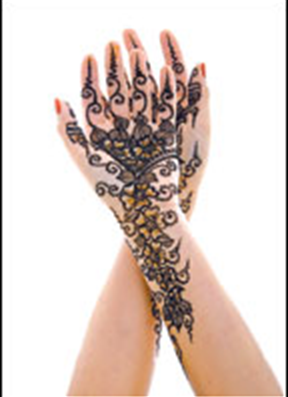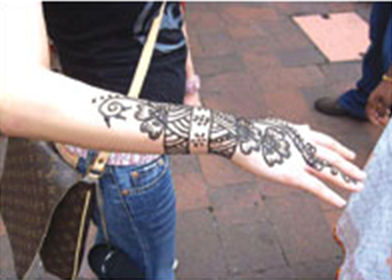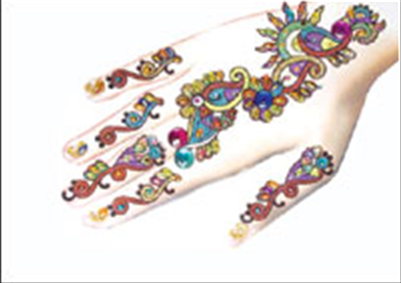Mehndi and Eid
This is a collection of articles archived for the excellence of their content. Readers will be able to edit existing articles and post new articles directly |
Mehndi and Eid
Eid Is Incomplete Without Mehndi
By Amber Saleem
Every society is associated with some festivals that are religious or custom or tradition based. The two major festivals that are celebrated by the entire Muslim nation with great religious enthusiasm are Eidul Fitr and Eidul Azha.
Eidul Fitr is celebrated after Ramazan as a reward of fasting from Almighty Allah. In Pakistan, people seem more excited for Eid’s preparation than Eid’s celebration and this excitement is mostly observed during the last days of Ramazan. Girls, besides arranging for their dresses, matching shoes and jewellery, also wait for hours in beauty parlours to have their hands and feet decorated with mehndi, aka henna. For many girls, Eid’s celebration is incomplete without mehndi.
Mehndi has been used for centuries to decorate palms and feet. Before the modern era mehndi, which is easily available in the form of powder and cones, this adornment stuff was prepared at home by grinding the leaves of mehndi plant, which was mixed with water and oil to form a paste. There was not any concept of aesthetic designs of mehndi as it’s now. Mehndi was simply coated on the palms and feet. However, one design was popular — a circle drawn in the centre of the palm and filled with mehndi. Then a cap was formed on the fingers, as if they had been dipped in mehndi. This design is used these days as well but with a lot of artistic amendments. Then people started making design with the help of toothpick before cones became available.
Invention of cone and tube mehndi brought a new revolution and mehndi has been elevated to the status of art and a fashion adornment for young girls. Nowadays, application of mehndi depends on dressing. There are very intricate designs that are drawn on both sides of the hands, arms, neck and on feet.
There are many different styles of mehndi, depending on the cultural background they come from. The most famous ones are Arabic, Pakistani, African and Indian.
Arabic mehndi style tends to be less detailed and intricate. Instead of having fill-ins it is just coloured in boldly. Many popular Arabic designs are vines and leaves with beautiful flowers. Pakistani mehndi style is the most detailed and intricate. Indian and Pakistani designs encompass more than just the feet and hands and generally extend further up the appendages to give the illusion of gloves and stockings which are made up of lines, paisley patterns and teardrops.
African mehndi style is mainly bold, big designs with thick lines. These designs usually consist of geometric shapes and figures, also many lines and dots.
Mehndi has been an inspiration to the imagination and creativity of the artists. Make your own designs-left or right-handed, simple or complex. After the design is complete, leave it overnight! Make sure mehndi is not too thin, it should be pasty in form so it can stick to the skin. To remove mehndi paste, you can use oil. It can be any oil, depending on preference and skin type. Do not scrub the paste off, because this prematurely exfoliates the first layer of the skin, and the design will not last as long.
The mehndi design patterns are simple to do and they are truly fun watching one on your body. These days glitter of different shades is also used in designs for filling and for shading in flowers.
Mehndi tattoos and stickers are also in; they give you a glam look. Mehndi tattoos and stickers are easy to apply, no side effects at all, the colour is temporary and you can wear any design according to the occasion. These tattoos and stickers can be found in all departmental stores in the cosmetic section. Tattoo paint when applied on hands must be left on for several hours for good result.
Below are some tips for better results:
• Take lemon juice in a bowl; add sugar to make it sticky. Apply this mixture to the area where the mehndi is to be applied with a clean cotton patch. It will keep the mehndi paste glued to the applied areas. The longer you leave the paste on, the stronger the colour will be.
• Apply Vicks after washing hands.
• Another tip is to add disprin in water, and dip your hand in this water for about five minutes.
• To make your mehndi design last longer, you should keep it moisturised with some sort of oil. Apply oil before going into the shower, bath, pool, etc. And when in the sun, be sure to keep sun screen over the mehndi design.




